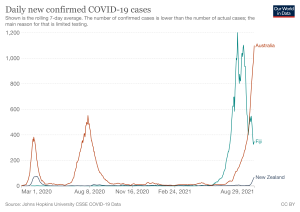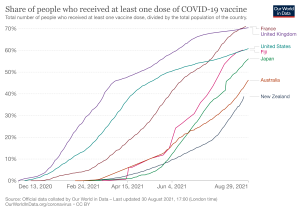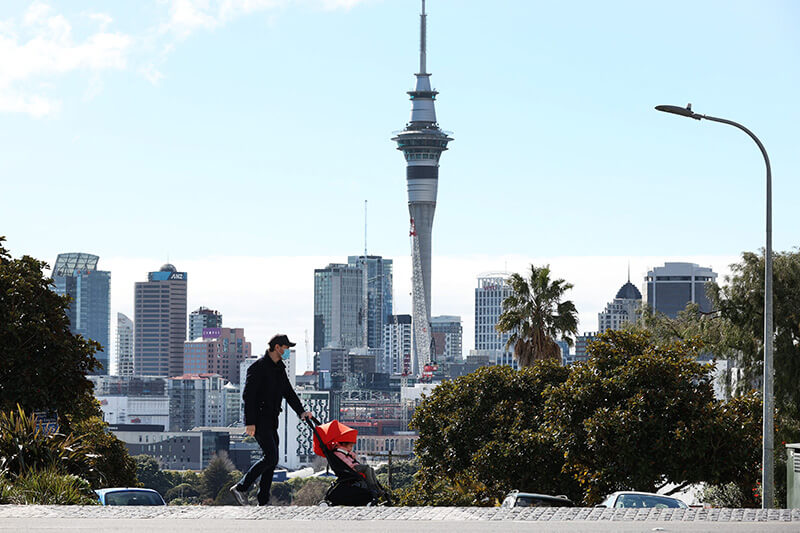Two weeks ago, the headlines out of New Zealand were as simple as they were strange.
After a single positive case of Covid-19, the South Pacific nation headed into a strict nationwide lockdown.
Kiwis panic bought toilet paper, baked bread, and worried about how close they could exercise next to another person outdoors. Meetings and classes went to Zoom. Selfies were taken with masks on.
For a world jaded by a global pandemic that has claimed more than 4.5 million lives and transformed much of daily life, the news almost felt bemusing; an odd throwback to March 2020.
Overseers of the world’s last truly successful national ‘elimination’ strategy, New Zealand has enjoyed nearly a year and a half without masks, social distancing, and health care system strain. Only 26 New Zealanders have died of Covid-19, all aged over 60.
Now in replication, strict national lockdown measures extinguished community transmission by May last year. Widespread public trust in public health messaging has been hugely important, as have testing and tracing techniques.
Until the current outbreak of the Delta variant—which has seen 562 people test positive so far—a state-mandated managed isolation quarantine (MIQ) system has kept Covid-19 at bay, at the border.
Delta does raise some big questions that we’re going to have to grapple with, you know less than a 24-hour period for someone getting it and passing it on to others … that’s like nothing we’ve dealt with in this pandemic so far, and it does change everything.
New Zealand’s current falter is far more revealing of its actual pandemic preparedness than recent viral photos of sold-out rock concerts and packed sports stadiums would have many around the world believe.
Hampered by shockingly slow government efforts to procure and distribute vaccines, New Zealand’s vaccination rollout stands amongst the slowest through developed countries. Around one in four Kiwis are fully vaccinated against Covid-19.
Though avoiding the Covid-created strain regional neighbors Australia and Fiji are facing, New Zealand’s public health care system remains chronically under-resourced and funded. Most medium-sized American cities have more ICU beds than New Zealand, which boasts just one pediatric ICU.
A system now temporarily barring its own citizens from returning home, technical and organizational issues have beset MIQ for months. Human rights lawyers are currently investigating its legality.
With Auckland—New Zealand’s biggest city—likely to remain under harsh lockdown measures for weeks to come, the Kiwi government—led by Prime Minister Jacinda Ardern—is starting to feel significant heat for missteps earlier Covid-19 brushes obscured.
Plateauing positive cases point to the current outbreak being contained. Still, Kiwis are starting to arrive upon the realization that its success has created Covid-19 complacency — and that a perfect solution to the pandemic problem may not actually exist.
“The rest of the world is embracing its post-pandemic future while New Zealand enters a […] time warp,” Stuff’s Andrea Vance wrote.
‘Going hard and early’
Along with its geographic isolation and small, low-density population, the heart of New Zealand’s ‘elimination’ approach is its four-tiered lockdown system.
As was the case early last year, the whole country went to Level 4 lockdown when ‘Case A’—a 58-year-old Auckland builder returning from Australia—tested positive on August 16.
Under its rules, residents can only leave their houses to exercise, get groceries, petrol, medicine, or go to the hospital. Only essential workers are allowed to work with most non-digital businesses shut down. Funerals are barred. Fast food restaurants aren’t even allowed to deliver.

Constructed from lessons learned in the pandemic’s early days in China, Italy, and Spain, the approach is one of the world’s most restrictive. By “going hard and early,” pursuing comprehensive testing and tracing, and having a populace that stuck to the lockdown rules, Covid-19’s early variations were denied a community foothold.
“Doing this early on with only over a few thousand cases [worldwide] at the time allowed them to basically stop the influx and stop the community transmission,” Professor Martin Berka, an economist at New Zealand’s Massey University, told the BBC about the lockdown’s success last year.
The early success is undeniable. Including recent outbreak numbers, New Zealand has recorded just 3520 overall positive cases. Alabama currently has a daily average of 4055 new positives.
Though previous months have seen things unravel for both Australia and Fiji, similar ‘elimination’ approaches worked for most South Pacific nations. Samoan, Tonga, and the Cook Islands—all of whom have large NZ-based populations—have still yet to officially record a single Covid-19 case.
This year, an Australia—New Zealand travel bubble was opened between April and July, as did others with Polynesian satellite nations. Though required by those moving within travel bubbles, MIQ slowed all other movements into New Zealand.
Outside a handful of required skilled workers after serving a two-week hotel room quarantine to prove they were Covid-19 free. Long lauded by its politicians, the system held the virus at arm’s reach.
It has not been without a cost, however. Sequestered by the government, participating hotels were limited, effectively capping potential entries. With bots and scripts used to outflank the online booking system, ongoing technical issues have caused months-long waits for rooms for ex-pat Kiwis.
Doing this early on with only over a few thousand cases [worldwide] at the time allowed them to basically stop the influx and stop the community transmission.
Some have already lost their right to vote because of it. Human rights lawyers are currently looking into the legality of the whole system, which citizens must pay more than US$2000 to use.
“If in practice the system is creating a discriminatory effect because people just can’t access the system as quickly as others, then that is breaching the Government’s legal obligations,” Andrew Geddis, a University of Otago law professor, told the New Zealand Herald in July.
‘Locations of interest’
New Zealand’s second national lockdown snapped into action less than two days after ‘Case A’ delivered his positive test for the Delta Variant.
In the days before he tested positive, “Case A’ visited a small beach town, watched a rugby game at his local pub, and stopped in at several service stations, cafes, and restaurants. Like those around him, he didn’t wear a mask and wasn’t practicing social distancing.
Hundreds of ‘locations of interest’ were quickly identified with more than 20,000 potential contacts in Auckland alone. More than 60 percent of those were contacted and told to self-isolate thanks to a largely successful QR scanning network.
Though the weekend saw daily positive cases head over 80 for the first time during the pandemic, signs are strong that New Zealand will contain Covid-19 once again.
Yesterday, just 53 new positive cases were detected. Though the Auckland and Northland regions will stay on Level 4, Ardern has announced most of the country will move down to Lockdown Level 3 next week.
Like last year, the early low numbers have allowed New Zealand to institute rapid genomic sequencing of cases, providing fast evidence of where clusters of cases got their initial dose. The current outbreak has already been linked back to Australia—and local groups to other local clusters.

“With conditions controlled to the degree that’s simply not possible elsewhere, the country behaves like a laboratory for the world [for Covid-19 genomic sequencing],” Tess McClure wrote for the Guardian in April.
Kiwi public health messaging has stayed as impressive throughout the pandemic. Along with Ashley Bloomfield, NZ’s Director-General of Health, Ardern fronts a daily press conference updating the public about the outbreak. A former World Health Organization (WHO) official, Bloomfield is regarded as New Zealand’s Anthony Fauci.
Yet despite their effective control of information and encouragement of Kiwis to ‘stay the course’, Ardern and Bloomfield’s leadership can’t obscure the harsh reality of New Zealand’s sluggish vaccination rollout.
As of Monday, New Zealand’s current full vaccination rate was 26.7%, the lowest in the Organization for Economic Co-operation and Development (OECD). 23.4% of Kiwis have had one shot. Kazakhstan, Cuba, Montenegro, and Panama all boast superior vaccination rollouts.
Last year, Kiwi leaders said early vaccine supplies should be directed to countries suffering the most from Covid-19. Though an admirable moral stance, it revealed a lack of urgency that underscores New Zealand’s current pandemic placement.
A couple of vaccination deals fell through before they shook hands with Pfizer. Even once the initial supply was available, the rollout proved slow. After first making the jab available to the essential border and port workers, it was made available to the elderly and other high-risk groups.
Aged brackets were introduced, which remain in place until tomorrow. Though the government stated they would prioritize minority communities, vaccinations amongst Maori and Pacific Islander New Zealanders remain low.
“Once we got past the supply and storage issues, we should have been ready to go then, not trying to onboard them now,” New Zealand Pharmacy Guild boss Andrew Gaudin told Stuff, last week.
Before the current lockdown, public urgency to get a shot remained low in New Zealand. Even Bloomfield only got his first dose last week.
The last week has seen a massive rise in vaccine sign-ups that health officials worry could exhaust the country’s current supply before new Pfizer shipments arrive. The rollout has so far peaked at 90,000 shots a day, but demand pressures could force rates down to 30,000 a day over coming weeks.
There is hope that [Covid-19] vaccinations will act to uncouple infection from hospitalization and death. That is a major step in itself, particularly if we are to keep our health services above water.
Last year’s lockdown success has provided a fig leaf for New Zealand’s ailing public healthcare system, too. New Zealand entered the Covid-19 pandemic with the second-lowest number of ICU beds per capita in the OECD, trailing only Mexico.
Currently, there are just 284 fully-staffed ICU beds across New Zealand’s public hospitals, along with 762 ventilators if the national reserve was fully used. New Zealand also only has one pediatric ICU, located in Auckland. Cities like Memphis and Nashville have more of each.
With no big switch to remote work or learning, the pandemic’s impact on medicine and medical education was muted throughout the region — but staffing issues remain.
Poorly paid by the public system, Kiwi nurses have been striking recently. A growing need for international physicians to help an understaffed system has been held up by restrictive immigration rules.
“There is hope that [Covid-19] vaccinations will act to uncouple infection from hospitalization and death,” Dr. Alex Kazemi, an Auckland public health expert, wrote for The Spinoff. “That is a major step in itself, particularly if we are to keep our health services above water.”
New Zealand’s tricky Covid offramp
Though its overall success is undeniable, New Zealand’s Covid-19 experience still points to an age-old truth: that even in a pandemic, success can breed complacency.
“No navigation system could plot a route … when the terrain is shifting as fast as it does under our feet now,” Kazemi wrote. “The elimination strategy has saved many lives and thrown a lifeline to the healthcare system, but we are not in control of what happens beyond our borders.

“When people say the virus will become inevitably endemic, it’s not clear that they always understand the range of scenarios endemicity can cover, or how bad it could be for already strained healthcare systems.”
For New Zealand to make it to their pandemic off-ramp as gracefully as much of their Covid-19 journey, shots need to go into arms. Supported by a better-resourced health care system, Australia has set an upper target of between 70% and 80% of the total populace vaccinated before stopping lockdowns.
Though similar figures have been mentioned in New Zealand as reachable by the end of 2021, vaccination resistance and reluctance are growing in the Long White Cloud Land. Up to one in three were skeptical about getting a shot as recently as March.
Changes in MIQ are long overdue. Shorter quarantine for vaccinated returnees seems an obvious fix, as does opening it up for vaccinated travelers who wish to travel to, or do business in, New Zealand.
Despite all the talk about the feasibility of ‘elimination,’ Kiwi leaders are beginning to acknowledge the same reality that Kezami sees.
In a post-pandemic, Covid-19 endemic world, the strategy becomes redundant for a small nation whose cultural, social, and economic impacts will grow with closed borders.
The rest of the world is embracing its post-pandemic future while New Zealand enters a […] time warp.
Kiwis would rather deal with great or strange news headlines rather than negative ones. The coming weeks and months will determine the ratio.
“Delta does raise some big questions that we’re going to have to grapple with, you know less than a 24-hour period for someone getting it and passing it on to others … that’s like nothing we’ve dealt with in this pandemic so far, and it does change everything,” Chris Hipkins, New Zealand’s cabinet minister in charge of Covid-19, told TVNZ’s Q&A recently.
“It does mean that all of our existing protections … start to look less adequate and less robust as a result of that we are looking very closely at what more we can do there, but, yes, it does raise some pretty big questions about what the long-term future of our plans are.
“At some point, we will have to start to be more open in the future.”
Title image by Fiona Goodall/Getty Images



